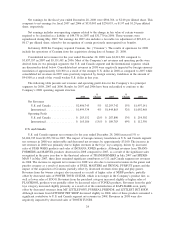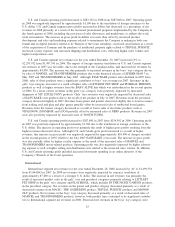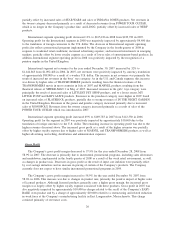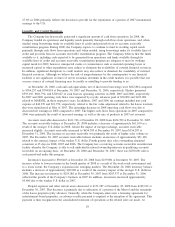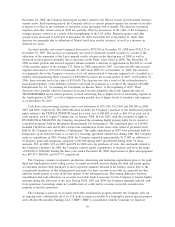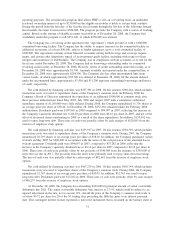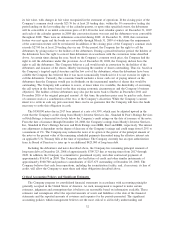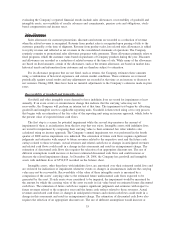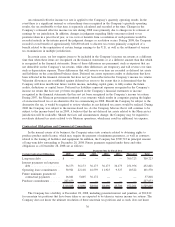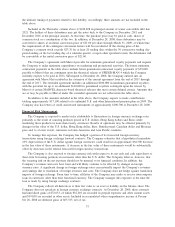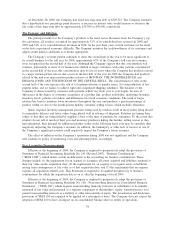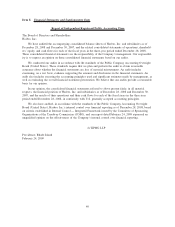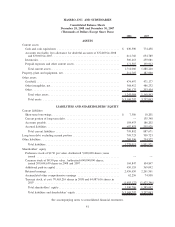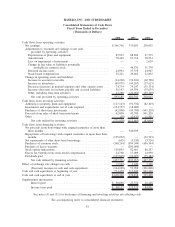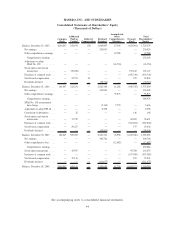Hasbro 2008 Annual Report Download - page 44
Download and view the complete annual report
Please find page 44 of the 2008 Hasbro annual report below. You can navigate through the pages in the report by either clicking on the pages listed below, or by using the keyword search tool below to find specific information within the annual report.
decrease estimated discounted cash flows and could increase or decrease the related impairment charge.
Intangible assets covered under this policy were $492,674 at December 28, 2008. During 2008, there were no
impairment charges related to these intangible assets.
Recoverability of Royalty Advances and Commitments
The recoverability of royalty advances and contractual obligations with respect to minimum guaranteed
royalties is assessed by comparing the remaining minimum guaranty to the estimated future sales forecasts and
related cash flow projections to be derived from the related product. If sales forecasts and related cash flows
from the particular product do not support the recoverability of the remaining minimum guaranty or, if the
Company decides to discontinue a product line with royalty advances or commitments, a charge to royalty
expense to write-off the non-recoverable minimum guaranty is required. The preparation of revenue forecasts
and related cash flows for these products requires judgments and estimates. Actual revenues and related cash
flows or changes in the assessment of anticipated revenues and cash flows related to these products could
result in a change to the assessment of recoverability of remaining minimum guaranteed royalties. At
December 28, 2008, the Company had $70,982 of prepaid royalties, $44,329 of which are included in prepaid
expenses and other current assets and $26,653 which are included in other assets.
Pension Costs and Obligations
The Company, except for certain international subsidiaries, has pension plans covering substantially all of
its full-time employees. Pension expense is based on actuarial computations of current and future benefits
using estimates for expected return on assets and applicable discount rates. At the end of 2007 the Company
froze benefits under its two largest pension plans in the U.S., with no future benefits accruing to employees.
The Company will continue to pay benefits under the plan consistent with the provisions existing at the date
of the plan benefit freeze.
The estimates for the Company’s U.S. plans are established at the Company’s measurement date. In
accordance with the provisions of Statement of Financial Accounting Standards No. 158, “Employers’
Accounting for Defined Benefit Pension and Other Postretirement Plans”, (“SFAS No. 158”), the Company
uses its fiscal year-end date as its measurement date to measure the liabilities and assets of the plans and to
establish the expense for the upcoming year.
The Company estimates expected return on assets using a weighted average rate based on historical
market data for the investment classes of assets held by the plan, the allocation of plan assets among those
investment classes, and the current economic environment. Based on this information, the Company’s estimate
of expected return on U.S. plan assets used in the calculation of 2008 pension expense for the U.S. plans was
8.75%. A decrease in the estimate used for expected return on plan assets would increase pension expense,
while an increase in this estimate would decrease pension expense. A decrease of 0.25% in the estimate of
expected return on plan assets would have increased 2008 pension expense for U.S. plans by approximately
$685.
Discount rates are selected based upon rates of return at the measurement date on high quality corporate
bond investments currently available and expected to be available during the period to maturity of the pension
benefits. The Company’s discount rate for its U.S. plans used for the calculation of 2008 pension expense
averaged 6.34%. A decrease in the discount rate would result in greater pension expense while an increase in
the discount rate would decrease pension expense. A decrease of 0.25% in the Company’s discount rate would
have increased 2008 pension expense and the 2008 projected benefit obligation by approximately $165 and
$7,972, respectively.
In accordance with Statement of Financial Accounting Standards No. 87, “Employers Accounting for
Pensions”, actual results that differ from the actuarial assumptions are accumulated and, if outside a certain
corridor, amortized over future periods and, therefore generally affect recognized expense in future periods. At
December 28, 2008, the Company’s U.S. plans had unrecognized actuarial losses of $87,906 included in
accumulated other comprehensive income related to its defined benefit pension plans compared to $19,158 at
December 30, 2007. The increase primarily reflects a decrease in the fair value of plan assets in 2008. Pension
34


